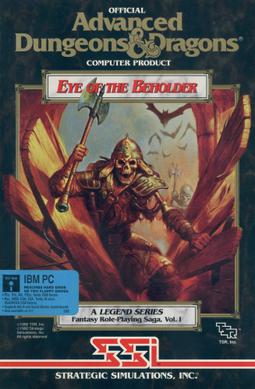http://en.wikipedia.org/wiki/Eye_of_the_Beholder_(video_game)
Información:
Eye of the Beholder (video game)
From Wikipedia, the free encyclopedia
| This article needs additional citations for verification. (March 2011) |
| Eye of the Beholder | |
|---|---|
 MS-DOS Cover art | |
| Developer(s) | Westwood Associates |
| Publisher(s) | Strategic Simulations, Inc. Capcom (SNES) Sega (Sega CD) Pony Canyon, Inc. (PC-98) |
| Composer(s) | Yuzo Koshiro (PC-9801, Sega CD) Motohiro Kawashima (Sega CD) |
| Platform(s) | MS-DOS, Amiga,Sega CD, SNES, PC-98 |
| Release date(s) | 1991 (MS-DOS) 1991 (Amiga) 1992 (PC-98) 1994 (SNES, Sega CD) |
| Genre(s) | Role-playing video game |
| Mode(s) | Single-player |
| Distribution | Floppy disk, CD-ROM |
Eye of the Beholder is a role-playing video game for computers and video game consoles developed by Westwood Studios. It was published by Strategic Simulations, Inc. in 1991 [1][2] for the MS-DOS operating system and later ported to the Amiga, the Sega CD,Game Boy Advance and the SNES. The Sega CD version features an exclusive soundtrack composed by Yuzo Koshiro.[3] A port to theAtari Lynx handheld was developed by NuFX in 1993, but never officially released.
The game had two sequels, Eye of the Beholder II: The Legend of Darkmoon, released in 1991, and Eye of the Beholder III: Assault on Myth Drannor, released in 1993. The third game, however, was not written by Westwood, who had been acquired by Virgin Interactive in 1992 and created the Lands of Lore series instead.
Contents
[hide]Plot[edit]
The lords of the city of Waterdeep hire a team of adventurers to investigate an evil coming from beneath the city. The adventurers enter the city's sewer, but the entrance gets blocked by a collapse caused by Xanathar, the eponymous beholder. The team descends further beneath the city, going through Dwarf and Drow clans, to Xanathar's lair, where the final confrontation takes place.
Once the eponymous beholder is killed, the player would be treated to a small blue window describing that the beholder was killed and that the adventurers returned to the surface where they were treated as heroes. Nothing else was mentioned in the ending and there were no accompanying graphics. This was changed in the later released Amiga version, which featured an animated ending.
Gameplay[edit]
Eye of the Beholder featured a first-person perspective in a three-dimensional dungeon,[4] similar to Dungeon Master.[5] The player controls four characters, initially, using a point-and-click interface to fight monsters.[4] This can be increased to a maximum of six characters, by resurrecting one or more of the dead NPCs bone remains or finding NPCs that are found throughout the dungeons.
The possibility to increase the size of the player's party through the recruiting of NPCs was a tradition in all of the Eye of the Beholder series. It was also possible to import a party from Eye of the Beholder into The Legend of Darkmoon or from The Legend of Darkmooninto Assault on Myth Drannor; thus, a player could play through all three games with the same party.
Sequels[edit]
Eye of the Beholder II: The Legend of Darkmoon[edit]
| Eye of the Beholder II: The Legend of Darkmoon | |
|---|---|
| Developer(s) | Westwood Associates |
| Publisher(s) | Strategic Simulations, Inc. Cybille (FM Towns) Capcom (PC-98) |
| Platform(s) | MS-DOS, Amiga,FM-Towns, PC-98 |
| Release date(s) | 1991 (MS-DOS) 1992 (Amiga) 1993 (FM Towns, PC-98) |
| Genre(s) | Role-playing video game |
| Mode(s) | Single-player |
Eye of the Beholder II: The Legend of Darkmoon used a modified version of the first game's engine, added outdoor areas and greatly increased the amount of interaction the player had with their environment, along with substantially more 'roleplaying' aspects to the game.
Plot: After the adventures of the first game, the heroes head to a local inn to rest and enjoy their newfound fame but a note gets slipped to them from Khelben "Blackstaff" Arunsun (Archmage of Waterdeep) who says that he sent a scout (Amber, a female elven thief/mage of neutral good alignment) to investigate reports of evil brewing in a temple known as Darkmoon but she has not returned. Khelben then transports the heroes to the temple to find Amber and continue the investigation, but it soon becomes apparent that not everything is as it seems....
The gameplay remains within the confines of the temple but players have to explore the vast catacombs beneath, the upper levels of the temple, and the three towers...azure, silver and finally crimson where they can fight the evil Dran Draggore. Like the first game in the series, this one was also ported to the Amiga systems.
Eye of the Beholder III: Assault on Myth Drannor[edit]
| Eye of the Beholder III: Assault on Myth Drannor | |
|---|---|
| Developer(s) | Strategic Simulations, Inc. |
| Publisher(s) | Softgold Computerspiele Ving Co., Ltd. (PC-98) |
| Platform(s) | MS-DOS, PC-98 |
| Release date(s) | 1993 (MS-DOS) 1994 (PC-98) |
| Genre(s) | Role-playing video game |
| Mode(s) | Single-player |
Eye of the Beholder III: Assault on Myth Drannor was not developed by Westwood Studios, the developer of Eye of the Beholder andThe Legend of Darkmoon, but rather in-house by the publisher SSI. Despite employing an updated version of the engine, interesting and oft-unique NPC selection and welcome gameplay tweaks such as an 'All Attack' button and the ability to use polearms from second rank, it was not well received. Reviews criticized the oversized and maze-like maps, lag issues, unchallenging battles, poorly designed puzzles and uninteresting storyline.[citation needed]
Plot: After defeating Dran the heroes tell the patrons of a local tavern about their success over Dran Draggore and how it saved the town. After that, a mysterious man enters the tavern and asks the heroes to save the ruined city, Myth Drannor, which is ruled by a Lich named Acwellan. The man then tells the heroes that they need to save Myth Drannor by getting an ancient artifact from the Lich known as the Codex. After the heroes foolishly accept the quest, the mysterious man teleports the heroes just outside of Myth Drannor.
The explorable areas include the forest around the city, the mausoleum, and finally the city ruins including a mage guild and a temple.
Collections[edit]
Eye of the Beholder Trilogy (1995, SSI) was a rerelease of all the three games for MS-DOS on CD-ROM. They also (as did a number of other AD&D DOS Games) appeared later in Gamefest: Forgotten Realms Classics (2001, Interplay).
Game Boy Advance version[edit]
| Dungeons & Dragons: Eye of the Beholder | |
|---|---|
 Game Boy Advance cover art | |
| Developer(s) | Pronto Games |
| Publisher(s) | Infogrames |
| Platform(s) | Game Boy Advance |
| Release date(s) | 2002 |
| Genre(s) | Role-playing video game |
| Mode(s) | Single-player |
A game titled Dungeons & Dragons: Eye of the Beholder was released for the Game Boy Advance that uses a "stripped down version of the 3rd edition D&D rules" with "only four basic character classes".[6] It is not a port of the original game, though it possesses roughly the same plot. It bears stronger resemblance to the original Gold Box games, such as Pool of Radiance.
According to GameSpy, this game "only managed to be a curiosity for older gamers and an annoying Western-style RPG for a new generation of Nintendo fans who had no idea what a Gold Box game was".[7]
Related games[edit]
Several modules for Neverwinter Nights have been created by fans as remakes of the original Eye of the Beholder game.[8]
Reception[edit]
The original Eye of the Beholder game was reviewed in 1991 in Dragon #171 by Hartley, Patricia, and Kirk Lesser in "The Role of Computers" column. The reviewers gave the game 5 out of 5 stars.[9] Dennis Owens of Computer Gaming World called it "a stunning, brilliantly graphic and agonizingly tricky" 3-D CRPG. The magazine stated that the game's VGA graphics and sound card audio finally gave IBM PC owners a Dungeon Master-like game.[5] Scorpia, another reviewer for the magazine, was less positive. Although also praising the graphics and audio, stating that they "really give you the feeling of being in an actual dungeon", she criticized the awkward spell user interface and the "outrageous" abrupt ending. Other areas that needed work, according to the reviewer, included the combat, plot, and NPC interaction; nonetheless, she was hopeful that with such improvements "the Legend series will become one of the leaders in the CRPG field".[10]
The Lessers reviewed Eye of the Beholder II: The Legend of Darkmoon in 1992 in Dragon #179, giving the game 5 out of 5 stars.[11]Scorpia of Computer Gaming World in 1992 again criticized the sequel's user interface, noting that monsters attacked in real time while the player searched through spell books, but stated that the game had a "fancy ending". She concluded that it was "a more substantial game" than its predecessor, with "more to do, a bigger variety of critters to fight and a larger area to explore".[12] That year the magazine nonetheless named it as one of the year's top role-playing games, stating that it followed in "the strong graphic and solid play-balance tradition of the original".[13]
According to GameSpy, despite the issues in the first Eye of the Beholder, "most players found the game well worth the effort".[14] GameSpy also commented that Eye of the Beholder II "sported a completely original ending, something that was badly needed, considering the game's biggest flaw -- the almost insane level of difficulty".[14] GameSpy also commented that "Eye of the Beholder III was a classic example of a company churning out a quick sequel to a good game and simply not giving it the love and care it really deserves".[15]
References[edit]
- ^ Minelli, Frank (1991). "The Rumor Bag". Computer Gaming World (79):16
- ^ QuestBusters, Vol. VIII, #2 (February 1991)
- ^ Barton, Matt (23 February 2007). "Part 2: The Golden Age (1985-1993)". The History of Computer Role-Playing Games. Gamasutra. Archived from the original on 30 March 2009. Retrieved 2009-03-26.
- ^ a b Tresca, Michael J. (2010), The Evolution of Fantasy Role-Playing Games, McFarland, p. 143, ISBN 078645895X
- ^ a b Owens, Dennis (June 1991). "Beauty is in the Eye of the Beholder". Computer Gaming World. p. 14. Retrieved 17 November 2013.
- ^ Kasavin, Greg (18 December 2002). "Dungeons & Dragons: Eye of the Beholder". GameSpot UK. Retrieved 2008-01-22.
- ^ Rausch, Allen (19 August 2004). "A History of D&D Video Games - Part V". GameSpy. Retrieved 17 November 2012.
- ^ "NWVault search for 'Eye of the beholder'". Retrieved 2009-03-08.
- ^ Lesser, Hartley, Patricia, and Kirk (July 1991). "The Role of Computers". Dragon (171): 57–64.
- ^ Scorpia (June 1991). "Scorpion's View". Computer Gaming World. p. 51. Retrieved 17 November 2013.
- ^ Lesser, Hartley, Patricia, and Kirk (March 1992). "The Role of Computers". Dragon (179): 57–62.
- ^ Scorpia (April 1992). "Scorpion's View". Computer Gaming World. p. 44. Retrieved 24 November 2013.
- ^ "CGW Salutes The Games of the Year". Computer Gaming World. 1992-11. p. 110. Retrieved 4 July 2014.
- ^ a b Rausch, Allen; Lopez, Miguel (16 August 2004). "A History of D&D Video Games - Part II". Game Spy.
- ^ Rausch, Allen (17 August 2004). "A History of D&D Video Games - Part III". Game Spy. Retrieved 17 November 2012.
External links[edit]
- Eye of the Beholder series at MobyGames
- Interview with the Eye of the Beholder Project for Neverwinter Nights (archived)
| ||






No hay comentarios:
Publicar un comentario